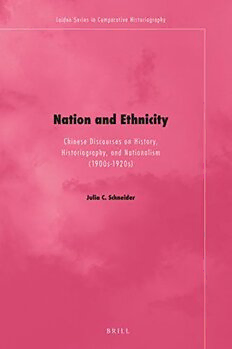
Nation and Ethnicity: Chinese Discourses on History, Historiography, and Nationalism (1900s–1920s) PDF
Preview Nation and Ethnicity: Chinese Discourses on History, Historiography, and Nationalism (1900s–1920s)
Nation and Ethnicity Leiden Series in Comparative Historiography Editors Axel Schneider Susanne Weigelin-Schwiedrzik VOLUME 11 The titles published in this series are listed at brill.com/lsch Nation and Ethnicity Chinese Discourses on History, Historiography, and Nationalism (1900s–1920s) By Julia C. Schneider LEIDEN | BOSTON The Library of Congress Cataloging-in-Publication Data is available online at http://catalog.loc.gov Typeface for the Latin, Greek, and Cyrillic scripts: “Brill”. See and download: brill.com/brill-typeface. issn 1574-4493 isbn 978-90-04-33011-5 (hardback) isbn 978-90-04-33012-2 (e-book) Copyright 2017 by Koninklijke Brill NV, Leiden, The Netherlands. Koninklijke Brill NV incorporates the imprints Brill, Brill Hes & De Graaf, Brill Nijhoff, Brill Rodopi and Hotei Publishing. All rights reserved. No part of this publication may be reproduced, translated, stored in a retrieval system, or transmitted in any form or by any means, electronic, mechanical, photocopying, recording or otherwise, without prior written permission from the publisher. Authorization to photocopy items for internal or personal use is granted by Koninklijke Brill NV provided that the appropriate fees are paid directly to The Copyright Clearance Center, 222 Rosewood Drive, Suite 910, Danvers, MA 01923, USA. Fees are subject to change. This book is printed on acid-free paper and produced in a sustainable manner. Für meinen Mann ∵ Contents Acknowledgements ix List of Maps and Tables Xi Abbreviations Xii Notes XIii Introduction 1 Part 1: Imperial Times 1 Liang Qichao: Nationalism and Historiography 67 2 Zhang Taiyan: The Republic of China as an Image 143 3 Liu Shipei: The Expulsion of the Non-Chinese People from China’s History 211 Part 2: The Republican Era The New Setting: Political Thinking after 1912 272 4 Non-Chinese People in Periodisations and Assimilationist Theories 283 5 The Genre of General Histories in the 1920s 330 Conclusion 381 Bibliography 399 Glossary of Chinese, Japanese, and Korean Terms 441 Index 474 Acknowledgements This book is the culmination of a longer project that began in 2006 at Heidel- berg University, interrupted for two shorter periods, resumed in 2009 at Ghent University, and finished at Göttingen University in 2016. Its larger part was written during my doctorate at Ghent University under the mentorship and guidance of my supervisors. I thus want to express my greatest thankfulness to Ann Heirman (Ghent University) for her careful comments and warm sup- port, Axel Schneider (University of Göttingen) for his help in approaching my topic in the context of Chinese historiography, and Eric Vanhaute (Ghent Uni- versity) for his help in understanding my topic in the wider context of global history. All supported me with their profound comments and their patience. I also thank the members of my doctoral defence committee, Bart Dessein (Ghent University), Christian Uhl (Ghent University), Stefan Haas (University of Göttingen), and Tze-ki Hon (New York State University, Geneseo) for their suggestions and encouragement. I always feel deep gratitude to Andrea Janku (formerly Heidelberg University, now SOAS). Among other important impulses she gave me as a student, the most important one was that she had me read Pamela Crossley’s “Thinking about ethnicity in early modern China.” Without this, this book would not have come into being. I also thank Rudolf Wagner and Barbara Mittler (both Heidelberg University) for their support at the beginning of the project, as well as the support of others from Heidelberg University who inspired me as a student, especially Lothar Wagner, who taught me to admire the beauty and finesse of the classical Chinese language. I thank friends and colleagues who helped me to develop my topic in many academic discussions, reading groups, and personal conversations; Mieke Matthyssen, Li Man, and Mathieu Torck from the Institute of Sinology, Ghent University; Milinda Banerjee, Ulrike Büchsel, Verena Lauer, and Élise Wintz from the Project A5, Cluster of Excellence “Asia and Europe,” Heidelberg University; from the Institute of Chinese Studies, Heidelberg University, Lena Henningsen (now Freiburg University) and Barbara Wall (now Hamburg University); Britta Büermann from the Department of East Asian Studies, University of Göttingen; and my friends and colleagues from the post- doc mentoring program at the University of Göttingen. Furthermore, I want to thank Francesca Fiaschetti (The Hebrew University of Jerusalem) for sharing more than one vision and making it reality in two workshops we co-organised (2011 at Ghent University, 2012 at Munich University); the speakers of these x acknowledgements workshops, who gave me many inspiring insights and ideas, especially Nicola Di Cosmo, Evelyn Rawski, and Pamela Crossley; and friends and colleagues I got acquainted with at conferences and from whose comments I greatly ben- efitted, above all Jeremy Gong and Leigh Jenco. I also thank several institutions for financial help, the Bijzonder Onderzoeksfonds (Special Research Fund), Ghent University, for a generous Ph.D. scholarship, and the Ministry for Science, Research, and Art, Baden- Württemberg, and the European Social Fund for a Ph.D. scholarship accord- ing to the Schlieben-Lange Programme at Heidelberg University. Moreover, I thank the German Academic Exchange Service (DAAD) and the Ministry of Education of the Republic of China (Taiwan) for travel grants. I also thank my proof-reader, Wendy Smyer Yu, for her careful reading and correcting; the editors of the series Leiden Series in Comparative Historiography, Susanne Weigelin-Schwiedrzik and Axel Schneider, the editors at Brill, Qin Higley and Victoria Menson, for their guidance and advice; and the two anony- mous reviewers whose comments and suggestions were most helpful in guid- ing my revisions. Of course, all remaining errors in this book are my own. Last though not least, I thank my family for their support, patience, and endurance. I dedicate this book to my husband, without whose moral and active support it could never have come into being.
